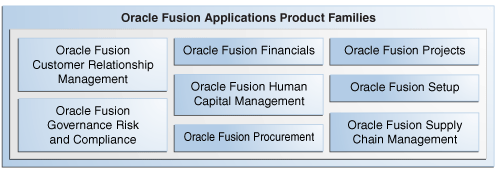How to Integrate with Oracle Fusion Applications
Blog: BPM Blog Avio Consulting

Introduction:

Oracle Fusion Applications includes the following product families or collections of products that are associated with a functional area:
- Oracle Fusion Customer Relationship Management manages customers, contacts, and resources, including data quality configuration.
- Oracle Fusion Financials manages financial flows, including assets, ledgers, cash cycle, invoices and payments, accounts receivable, collections, and setup of sub-ledger accounting and tax configuration.
- Oracle Fusion Governance, Risk, and Compliance integrates business intelligence, process management, and automated controls enforcement to enable sustainable risk and compliance management.
- Oracle Fusion Human Capital Management provides employee management for an organization.
- Oracle Fusion Procurement manages the procurement process including requisitions, purchase orders, and supplier negotiations.
- Oracle Fusion Project Portfolio Management manages projects, including how to plan, budget, forecast, collect costs, bill customers, and report performance.
- Oracle Fusion Supply Chain Management integrates and automates all key supply chain processes, from design, planning, and procurement to manufacturing and order fulfillment.
Integration Patterns
Extracts:
Extracts in the Oracle Fusion world is exactly what the word means, it is a flexible way to generate data files with a defined definition. The definition consists of:
- One or more extract data groups, depending on how many logical entities you want to extract.
- One or more extract records depending on how many groups of information you want to collect.
- One or more attributes depending on how many individual fields of data you want to collect.
Extracts can be very useful when you need to get larger datasets such as employee demographic data or budgets. Supported output formats for Oracle Fusion extract include CSV, XML, Excel, HTML, RTF, and PDF. These extracts can be configured to drop on to an SFTP server, send an email, or to be retrieved as a response to a web service. Data can also be encrypted using OOB features with the client specific keys which will make your security team very happy.
Reports
BI Reports defined in Fusion will give the ability for consumers to set the query parameters to get filtered data, for example, a particular group of employees rather than the entire dataset. These reports can be accessed by using a Web Service which makes them integration friendly. The response will be in base64 encoded format and output format includes XML, CSV, and others. Data cannot be encrypted and it doesn’t need to be since the transaction is being done over an HTTPS URL with a secured password.
Extracts vs Reports
When to choose what? – the short answer, it all depends on the use case. Some of the use cases and preferred approaches include:
Employee Demographic data to down steam systems: Extracts makes sense in this use case because the data is going to be huge and will have a standard definition.
Lookups: Reports makes more sense for lookups since they typically need selecting criteria.
SOAP and REST Services:
Oracle Fusion’s underlying complex of relational complicated data model doesn’t make it easy to use web services or REST services for all the functionalities. There are several web services offered by Oracle for integrating with different modules which are pretty straightforward to use. Even though Fusion use to be SOAP dominant earlier, Oracle is now offering more and more support to REST services in their recent releases. Web Services can be used even with ESS jobs.
Atom Feeds:
HCM Atom feeds provide notifications of Oracle Fusion Human Capital Management (HCM) events and is tightly integrated with REST services. When an event occurs in Oracle Fusion HCM, the corresponding Atom feed is delivered automatically to the Atom server. The feed contains details of the REST resource on which the event has occurred. Subscribers who consume these Atom feeds use the REST resources to retrieve additional information about the resource. These are the following primary Atom feeds:
- Employee Feeds
- New Hire
- Termination
- Employee Update
- Assignment creation, update, and end date
- Work Structures Feeds (Creation, update, and end date)
- Organizations
- Jobs
- Positions
- Grades
- Locations
Data through Atom feeds is particular to those feed enabled resources which means if it is not possible to get entire employee data for an action of employee update. Since each enterprise has its own challenges, there is no silver bullet to establish an integration pattern that fits all the needs. It all depends on the use case.
Leave a Comment
You must be logged in to post a comment.









Join the Conversation